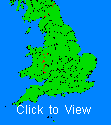Linfield Bloodline
Edward Linfield married Joane before 1543 to have 6 children who were baptised St Mary Magadalen parish church, Bolney, Sussex.
I believe him to be my 11 x great-grandfather and I have named and dated the births of over 6,000 descendants to the present day, and there will be many more yet to discover.
For all of his descendants (i.e. his children, his children's children, but not their spouses) down to the present day, I have mapped where
they were born, married or died as far as is known to me.
I am only including those events dated to within one year (or better) and at a defined place in England or Wales
(some of the Places are Registration Districts at which events were recorded rather than the actual Place of the event).
I have included people regardless of their surname. I have identified just under 1400 such events for this line
Maps

|
This map shows the total count of Births, Marriage and Death events of those descendants by Ancient County, across all years from his eldest child's birth to the present day.
The top county (most events) is clearly Sussex, followed by Surrey and then Kent.
|

|
This map shows the same events as above, but demonstrates that they were not evenly spread across the counties, but there were centres of activity.
The huge number of Sussex and Surrey events though, remove the ability to determine whereabouts in those counties the descendants were to be found.
|

|
This only includes Births (marriages and deaths now excluded), to help de-clutter the mapping; the top 18 places are named along with the birth-count there
Arbitrarily I have chosen the year 1900. It serves as a useful break-point for a change in the centuries-old ways of life and a transition to population mobility
and a move away from predominantly agricultural lifestyles.
It is clear that there was only one significant movement out of rural Sussex in the 350 years covered, stemming from a Sussex labourer moving to Croydon in 1850
and his descendants remaining there.
|
No
Map
|
I have not plotted post 1900 births, as with the availability of railway travel, and a population migration to larger towns and cities, with a great number of descendant families
there was significant movement and new family centre formation (seen in the first two maps above).
|

